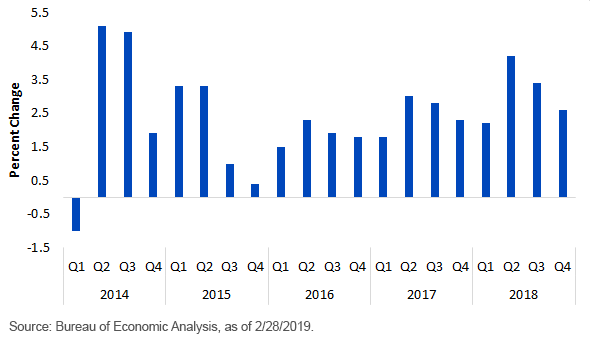By Kevin Flanagan, WisdomTree Investments
Special to the Financial Independence Hub
After at least a month-long delay, fixed income investors have finally been receiving economic data. With a number of government agencies closed due to the recent shutdown, 2019 began with a data vacuum, but now it looks like we are making up for lost time. Unfortunately, these “data delays” render some of the economic information potentially old or stale. Nevertheless, the data still offers insights as to how 2018 ended and can provide clues on any possible springboard effects for the current year.
U.S. Real GDP
While recession fears have been a part of the economic dialogue, the ongoing debate seems to be more centered on what type of slowdown we should expect in 2019. The accompanying graph illustrates that growth has trailed off a bit after reaching its most recent high-water mark of +4.2% in Q2. Some further deceleration is likely. In fact, Q1 2019 real GDP will likely be held down by the aforementioned shutdown, but then snap back in Q2 as those negative effects are reversed. Overall, real GDP in the area of +2¼% is my base case for this year.
Let’s take a look at the GDP engine cylinders:
Personal consumption expenditure (PCE): Household spending rose at a +2.8% annual clip in Q4, which translated to a 1.9 percentage point (pp) contribution to growth. This component should continue to be a positive force for the economy this year.
Gross private domestic investment: This category consists of two main sub-groupings, business and residential, which combined added 0.8 pp to the GDP. Business spending was on the plus side of the ledger, but housing came in negative. This cylinder will be difficult to gauge going forward, as higher mortgage rates could tilt it into the minus column.
Net exports (trade): There’s no surprise here, as trade remained a drag on growth in Q4. While some uncertainty could get removed with a U.S./China deal, the lasting effects of the dollar’s strength in 2018 may continue to act as a drag on future growth.
Inventories: Always a wild card of sorts, inventories actually put forth a positive contribution to GDP in Q4. If demand (household spending) doesn’t keep pace, this cylinder could switch course and be a negative force early in 2019.
Government spending: This category hit a positive note for the fifth consecutive quarter—albeit by a rather modest margin—and I would expect, on balance, further plus contributions going forward.
Conclusion
What does it all mean? From the Fed’s perspective: a patient business, as usual. For the U.S. Treasury market: The 10-year yield has bounced up a little—more than 10 basis points (bps) since around Presidents’ Day—and looks to be locked in a 2.55%–3.05% trading range on a shorter-term basis.
Unless otherwise noted, all data is from Data is Bureau of Economic Analysis, as of February 28, 2019.
Learn more in our new podcast series Basis Points with Kevin Flanagan.
As part of WisdomTree’s Investment Strategy group, Kevin Flanagan serves as Senior Fixed Income Strategist. In this role, he contributes to the asset allocation team, writes fixed income-related content and travels with the sales team, conducting client-facing meetings and providing expertise on WisdomTree’s existing and future bond ETFs. In addition, Kevin works closely with the fixed income team. Prior to joining WisdomTree, Kevin spent 30 years at Morgan Stanley, where he was most recently a Managing Director. He was responsible for tactical and strategic recommendations and created asset allocation models for fixed income securities. He was a contributor to the Morgan Stanley Wealth Management Global Investment Committee, primary author of Morgan Stanley Wealth Management’s monthly and weekly fixed income publications, and collaborated with the firm’s Research and Consulting Group Divisions to build ETF and fund manager asset allocation models. Kevin has an MBA from Pace University’s Lubin Graduate School of Business, and a B.S in Finance from Fairfield University



